
Cucurbita pepo is a cultivated plant of the genus Cucurbita. It yields varieties of winter squash and pumpkin, but the most widespread varieties belong to the subspecies Cucurbita pepo subsp. pepo, called summer squash.

The Texas leafcutter ant is a species of fungus-farming ant in the subfamily Myrmicinae. It is found in Texas, Louisiana, and north-eastern Mexico. Other common names include town ant, parasol ant, fungus ant, cut ant, and night ant. It harvests leaves from over 200 plant species, and is considered a major pest of agricultural and ornamental plants, as it can defoliate a citrus tree in less than 24 hours. Every colony has several queens and up to 2 million workers. Nests are built in well-drained, sandy or loamy soil, and may reach a depth of 6 m (20 ft), have 1000 entrance holes, and occupy 420 m2 (4,500 sq ft).

Parkinsonia, also Cercidium, is a genus of flowering plants in the pea family, Fabaceae. It contains about 12 species that are native to semi-desert regions of Africa and the Americas. The name of the genus honors English apothecary and botanist John Parkinson (1567–1650).

The Texas river cooter is a species of freshwater turtle endemic to the U.S. state of Texas. It is found in the river basins of the Brazos, San Bernard, Colorado, Guadalupe, San Antonio, Nueces, and their tributaries. It is one of three species of cooters (Pseudemys) occurring in Texas, including the Rio Grande cooter and the river cooter.
Lake Texana is a reservoir on the Navidad River, 8 miles (13 km) east of Edna, in Jackson County, Texas. The reservoir is formed by the construction of Palmetto Bend Dam. The dam and lake are managed by the Lavaca-Navidad River Authority, and supply water to surrounding communities and industries. Lake Texana is the only reservoir managed by the Authority.

Quercus texana, commonly known as Nuttall's oak, is a fast-growing, large deciduous oak tree.

Arbutus xalapensis, commonly known as the Texas madrone, Amazaquitl, or Texas madroño, is a species of flowering plant in the heather family. It is native to Central America, the southwestern United States, and throughout Mexico. It is found in canyons and mountains, on rocky plains, and in oak woodlands, at altitudes of up to 3,000 m in the south of the range, but lower, down to 600 m in the north of the range.
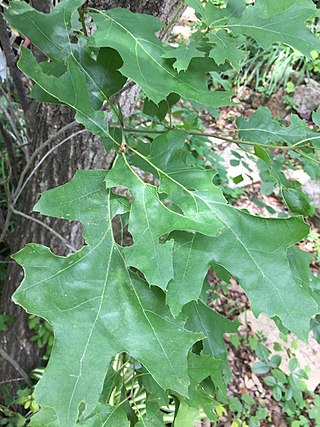
Quercus buckleyi, commonly known as Texas red oak, Buckley's oak, or Spanish oak is a species of flowering plant. It is endemic to the southern Great Plains of the United States.

Mocis is a genus of moths in the family Erebidae. The genus was erected by Jacob Hübner in 1823.
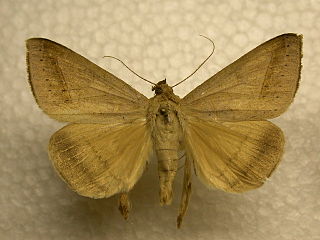
Mocis marcida, the withered mocis, is a species of moth of the family Erebidae. It is found from the coast of North Carolina to Florida, west to Texas, rarely straying northward as far as New York.

Mocis repanda, the striped grass looper, is a species of moth of the family Erebidae. It was described by Johan Christian Fabricius in 1794. It is found in Central America and the Caribbean, including Cuba, the Dominican Republic, Guadeloupe, Guatemala, Jamaica, Puerto Rico and Saint Thomas. Strays can be found in the United States, up to southern Texas as well as subtropical Africa south of the Sahara, including the islands of the Indian Ocean.
Texana denotes both the history and culture of Texas. It may also refer to:

Diospyros texana is a species of persimmon that is native to central, south and west Texas and southwest Oklahoma in the United States, and eastern Chihuahua, Coahuila, Nuevo León, and Tamaulipas in northeastern Mexico. Common names include Texas persimmon, Mexican persimmon and the more ambiguous "black persimmon". It is known in Spanish as chapote, chapote manzano, or chapote prieto, all of which are derived from the Nahuatl word tzapotl. That word also refers to several other fruit-bearing trees.
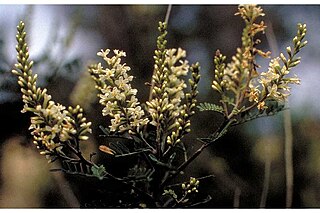
Eysenhardtia texana, commonly known as Texas kidneywood, bee-brush, or vara dulce, is a species of small flowering tree in the legume family, Fabaceae. It is found from south-central Texas south to northern San Luis Potosí in the Rio Grande Valley region of south Texas–Northeastern Mexico, and the species ranges into the eastern Chihuahuan Desert areas of Coahuila.
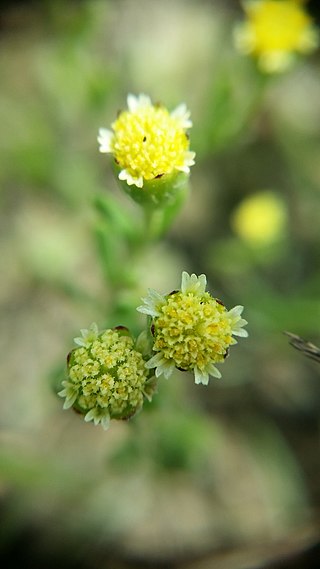
Hymenoxys texana is a rare species of flowering plant in the aster family known by the common names prairie dawn, Texas prairie dawn-flower, and Texas bitterweed. It is endemic to Texas, where it is known only from the general vicinity of Houston. It is threatened by the loss of its habitat. It is a federally listed endangered species of the United States.
Romeria is an extinct genus of Early Permian captorhinid known from Texas of the United States. It was first named by Llewellyn Ivor Price in 1937 and the type species is Romeria texana. R. texana is known from the holotype MCZ 1480, a three-dimensionally preserved skull. It was collected in the Archer City Bonebed 1 site, from the Archer City Formation, dating to the Asselian stage of the Cisuralian epoch, about 299–294.6 million years ago. A second species, Romeria primus, was first named by Clark and Carroll in 1973. In 1979, it was corrected as Romeria prima by Heaton. R. prima is known from the holotype MCZ 1963, a three-dimensionally preserved skull. It was collected in the Cottonwood Creek site, from the same horizon as the type species.
Gutierrezia texana is a North American species of flowering plant in the family Asteraceae known by the common name Texas snakeweed. It is native to the south-central United States and northern Mexico as far south as Guanajuato and Hidalgo.
Platynota texana is a species of moth of the family Tortricidae. It is found in Texas, United States.

Prunus texana, called peachbush, Texas almond cherry, Texas peachbush, sand plum, peach bush, and wild peach is native to central and western Texas. Although it looks like peach, it actually belongs to Prunus sect. Prunocerasus together with other North American plum species.
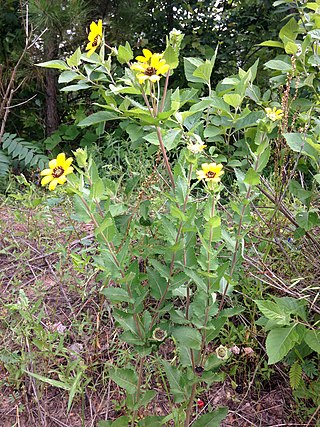
Berlandiera texana is a North American species of flowering plant in the family Asteraceae. It is commonly known as Texas greeneyes. It is native to the south-central United States, in the states of Texas, New Mexico, Oklahoma, Kansas, Missouri, Arkansas, and Louisiana.














